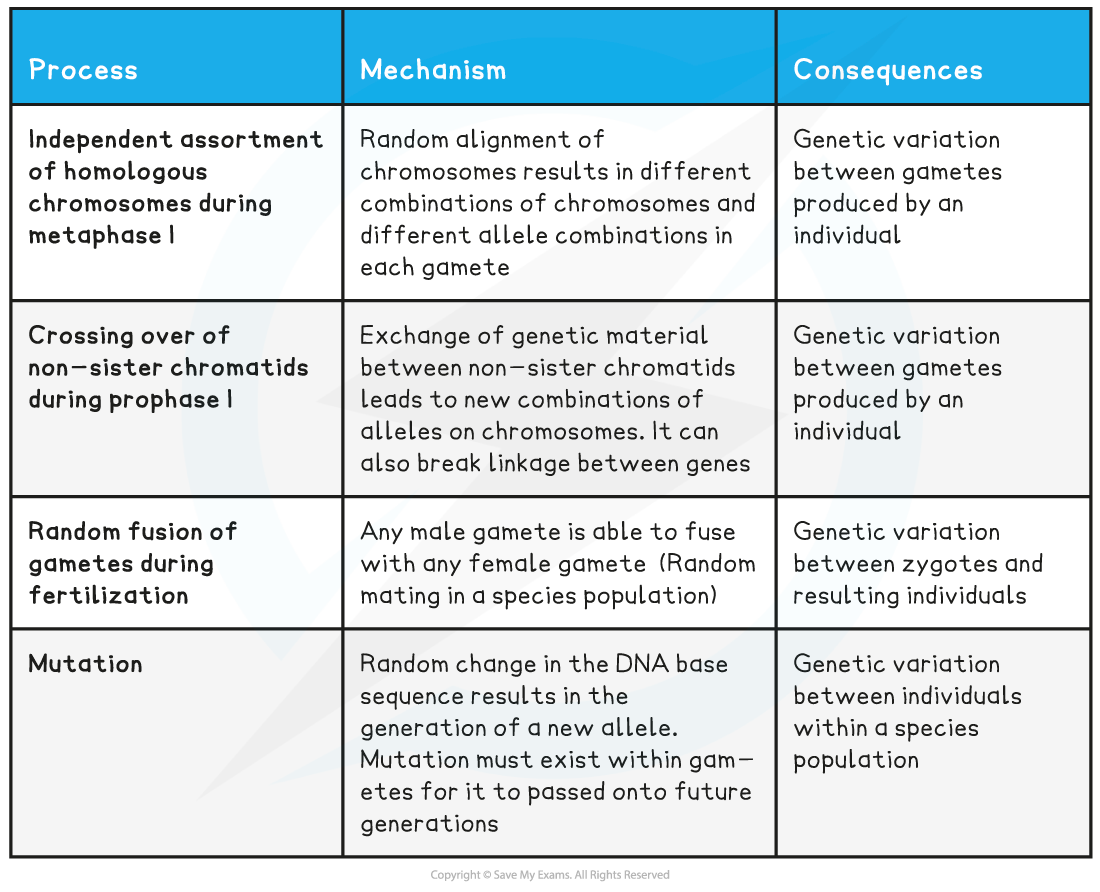Variation: Sexual Reproduction (OCR A Level Biology) : Revision Note
Variation: Sexual Reproduction
Organisms of the same species will have very similar genotypes, but two individuals will have differences between their DNA base sequences
Considering the size of genomes, these differences are small between individuals of the same species
The small differences in DNA base sequences between individual organisms within a species is called genetic variation
During sexual reproduction, genetic variation is transferred from one generation to the next and this generates phenotypic variation within a species
During sexual reproduction, genetic variation is caused by the following processes, as they result in a new combination of alleles in a gamete or individual:
Crossing over of non-sister chromatids during prophase I of meiosis
Independent assortment of homologous chromosomes during metaphase I of meiosis
Random fusion of gametes during fertilisation
Crossing over
Crossing over is the process by which non-sister chromatids exchange alleles
Process:
During meiosis I homologous chromosomes pair up and are in very close proximity to each other
The non-sister chromatids can cross over and get entangled
These crossing points are called chiasmata
The entanglement places stress on the DNA molecules
As a result of this a section of chromatid from one chromosome may break and rejoin with the chromatid from the other chromosome
This swapping of alleles is significant as it can result in a new combination of alleles on the two chromosomes
There is usually at least one, if not more, chiasmata present in each bivalent during meiosis
Crossing over is more likely to occur further down the chromosome away from the centromere


Crossing over of non-sister chromatids leading to the exchange of genetic material
Independent assortment
Independent assortment is the production of different combinations of alleles in daughter cells due to the random alignment of homologous pairs along the equator of the spindle during metaphase I
The different combinations of chromosomes in daughter cells increases genetic variation between gametes
In prophase I homologous chromosomes pair up and in metaphase I they are pulled towards the equator of the spindle
Each pair can be arranged with either chromosome on top, this is completely random
The orientation of one homologous pair is independent / unaffected by the orientation of any other pair
The homologous chromosomes are then separated and pulled apart to different poles
The combination of alleles that end up in each daughter cell depends on how the pairs of homologous chromosomes were lined up
To work out the number of different possible chromosome combinations the formula 2n can be used, where n corresponds to the number of chromosomes in a haploid cell
For humans this is 223 which calculates as 8 324 608 different combinations


Independent assortment of homologous chromosomes leading to different genetic combinations in daughter cells
Random fusion of gametes
Meiosis creates genetic variation between the gametes produced by an individual through crossing over and independent assortment
This means each gamete carries substantially different alleles
During fertilisation, any male gamete can fuse with any female gamete to form a zygote
This random fusion of gametes at fertilization creates genetic variation between zygotes as each will have a unique combination of alleles
There is an almost zero chance of individual organisms resulting from successive sexual reproduction being genetically identical

How meiosis and the random fusion of gametes affects genetic variation
Mutations
Although not specific to sexual reproduction, genetic variation can also be caused by mutations, as mutations can result in the generation of new alleles
The new allele may be advantageous, disadvantageous or have no apparent effect on phenotype (due to the fact that the genetic code is degenerate
New alleles are not always seen in the individual that they first occur in
They can remain hidden (not expressed) within a population for several generations before they contribute to phenotypic variation
Sources of Genetic Variation Table

Examiner Tips and Tricks
Several sources of genetic variation have been outlined above and you could be asked about any of these in the exam, so make sure you know the process behind each source! These sources of genetic variation explain why relatives can differ so much from each other. Even with the same parents, individuals can be genetically distinct due to the processes outlined above.Be careful though - as mutations occur all the time, they are not a source of genetic variation that is specifically brought about through sexual reproduction but are included here as they are still a significant cause of genetic variation within species.

You've read 0 of your 5 free revision notes this week
Unlock more, it's free!
Did this page help you?